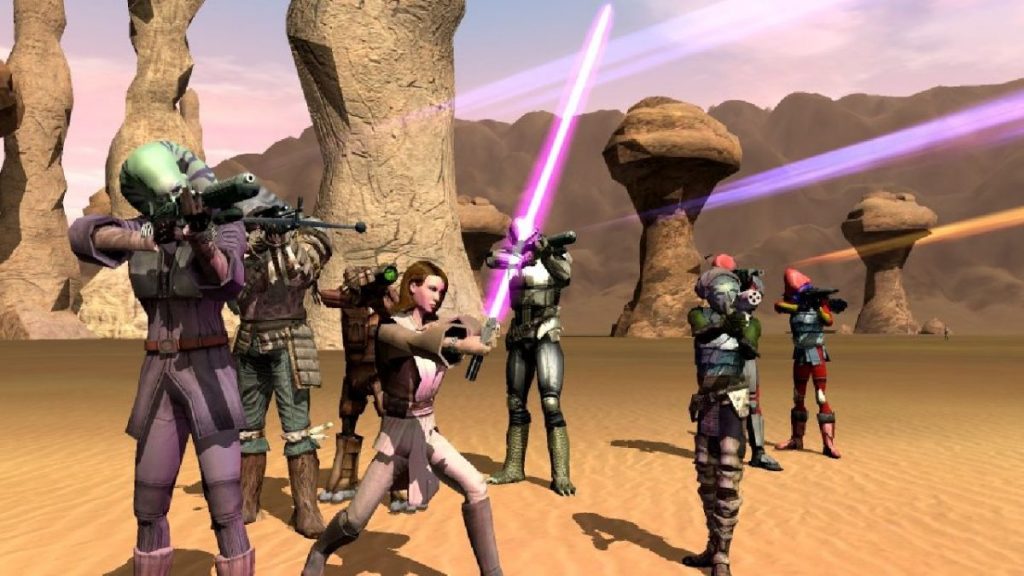The Evolution of the MMORPG Genre
The MMORPG genre is perhaps one of the most complex and expansive genres in video games.
They provide us an an easy escape from the grind that is our daily life, and allow for us to explore fantastical worlds filled with other players of varying backgrounds, likes, dislikes and personalities. They take the foundations that made role-playing games a success and then apply that on a massive scale.
I’ve spent the better half of 2 decades now playing MMOs and there isn’t a single moment of that time that I regret. Well.. okay maybe I made a few poor decisions, played some really low quality games or raged a little too furiously, but for the most part I don’t have any regrets.
Nevertheless, the genre has continued growing. Continued evolving since I started in it all the way back in the early 2000s. Sure, some people are under the impression that the MMORPG genre has been in a state of decline for years now, despite there being more players interested in online gaming than ever before.
And while I can’t speak for you, I can say that I’m merely waiting for a game to reignite that spark I once had – that allowed me to no-life these games as a kid.
The concept for the MMORPG – or the MMO, rather, dates all the way back to 1974. In 1974, Maze War introduced the very first networked game, allowing multiple players on separate computers to visually interact with one another within a contained virtual space.
Granted, this ran over a serial cable initially however over time they made enhancements allowing it to be played across the ARPANET – which, for those of you under 50 like myself, ultimately became the basis for the internet we know today.
The following year in 1975, Adventure was created, an adventure game that contained various features and references to the popular Dungeons & Dragons franchise.
In 1977, several MIT students got together and wrote a game called Zork that went on to garner quite a following on the ARPANET.

And here’s where things get interesting. I’m sure a lot of you know what MUD’s are, right? Multi-user-dungeons – a term that encompasses the entire text-based multiplayer real-time virtual genre, and proceeded to evolve into other variants like multi-user dimensions and multi-user domains.
Well, in 1978, Roy Trubshaw started development on an adventure game named MUD; Multi-User Dungeon. This was a tribute to Zork, which Roy had spent countless hours enjoying.
MUD’s saw a surge in popularity during the 1980s when people could afford to purchase personal computers, allowing role-players the capability of connecting to and logging in to multi-line Bulletin Board Systems and online service providers such as CompuServe.
In 1987, an idea for an online RPG “with a system that allows total freedom for the player” was presented. Yoshio Kiya, known mostly for his work as the creator of the Dragon Slayer RPG games went on to state “Despite the game being a sword and sorcery world, the hero decides to do nothing and just.. quietly enjoy his life as a local baker in town.
If everyone could take up different roles in some kind of computer networked game, I think it would be really fun.”
A couple years later in 1989, Avalon: The Legend Lives, who’s goal was to be the first “fully developed roleplaying world” was published. This was a title that elaborated on, and perfected the genre, setting a new standard for future games.
Avalon was the first game to introduce a fully-functional player-driven government, player-driven economy, allow for life-skilling such as farming with labor mechanics, skill-based PvP and more.
Many highly influential developers like Brad McQuaid of EverQuest fame and Raph Koster who created Ultima Online started as MUD developers, and spent time within the genre as players as well.
And while MUD’s were making quite a substantial amount of progress, at the same time the PLATO system was advancing in quite a few areas that MUD’s weren’t, with Spasim, and Talkomatic allowing for 32-player compatibility and a full multi-user chat system.
Where MUD’s were for the most part textual, games built using the PLATO system had actual rendered graphics that were highly advanced for their time. However, they were unable to grow beyond the system they were built on.

Here’s where we need to define the term “MMO.” In 2010, MMORPGs like World of Warcraft, Lineage, Perfect World International, and Ragnarok Online were averaging hundreds of thousands, if not millions of total active players every month. They allowed for hundreds, maybe thousands of players to concurrently occupy a single space in a world.
In 2020, MMORPGs like Phantasy Star Online 2, Final Fantasy XIV, and Guild Wars 2 average tens of thousands, if not hundreds of thousands of active players every month.
They have a much smaller cap on how many players can concurrently occupy a single space, however, with various MMOs like PSO2, Vindictus and Soul Worker actually presenting players with a “hub” of sorts where the bulk of non-combat time is spent.
However back during the franchises’ inception in 1985, the very first commercial MMORPG, Island of Kesmai was released to the public. This game cost players $12 per hour via the very same CompuServe online service I mentioned earlier, and supported a maximum of 100 total players.
Yup, even back in the 80s we had MMOs that were larger in scale than some of the MMOs made this generation. Think about that for a moment.
In 1986, Lucasfilm – yes, that Lucasfilm developed Habitat, the first attempt at a large-scale commercial virtual community with a fully-functional graphical system.
Yet it wasn’t until 1991 when Neverwinter Nights – not the BioWare RPG mind you, but an entirely separate title that the very first graphical MMORPG was released to the public via AOL. If you remember AOL, then you’re as old as me.
I’m sorry to be the one to have to tell you that. Neverwinter Nights cost $6 per hour to play, and ran from 1991 through 1997.
The following year The Shadow of Yserbius was released, running from 1992 through 1996. While you were required to pay an hourly fee to play the game, they did offer an unlimited monthly service fee of $120.
Yeah, you guys think World of Warcraft and Final Fantasy XIV charging $15 per month is bad? Try this. $120 per month, back in 1992 to play an MMO.

During the mid 90’s game companies began to invest in developing games for an online audience. Legends of Future Past, a popular MUD at the time was the first commercial text-based MMORPG to release onto the internet, and was one of the very first games to employ professional Game Masters to conduct events online for their players.
However, it wasn’t until 1997 when Richard Garriot, the creator of Ultima Online decided to coin the term “Massively Multiplayer Online Role Playing Game.” According to Wikipedia, the term derives from “MMOG,” which was used by Dale Addink to describe a confirmed kill back at E3 in 1995.
Both The Realm Online and Meridian 59 released in 1996. While Meridian 59 initially released before The Realm Online, being classified as “the first 3D graphical MMORPG,” it’s worth noting that The Realm Online had a Beta test running several months earlier than Meridian, operating on a 2D graphical engine both in and outside of combat.
Interestingly, both of the aforementioned MMOs are still running as of May 2021 which is a testament to the longevity of these titles and the playerbase that remains dedicated to them.
Following shortly after was the release of Nexus: The Kingdom of the Winds, a Korean MMORPG that released in 1996 alongside The Realm Online and Meridian 59. Like the two titles, it, too, is still alive.
Towards the end of 1996, Meridian 59 became one of the first internet MMORPGs released by a major publisher. It offered a full 3D graphical engine, providing a new perspective with which to view the world from their character.
This was also the first title to introduce the monthly subscription fee that we see in World of Warcraft and Final Fantasy XIV today.
1997 is when things really picked up for the MMORPG genre, and this is where I expect most of you were introduced to it. In 1997, Tibia was released to the public.
This is one of the oldest MMORPGs that still retain a semblance of an active community, housing tens of thousands of active players per month.
Tibia, unlike its predecessors, released as an entirely free to play MMO, but allowed for players to upgrade to a premium account that provided additional content to explore, features to be unlocked and other benefits free players wouldn’t have access to.
I guess you could say this was one of the first instances of paid DLC in MMOs? Perhaps pay to advance? I guess it depends on your definition of the term.
Alpha testing began for Ultima Online – generally considered one of the grandfathers of the genre, in January 1996, releasing fully in September 1997.
Ultima Online utilizes a 3D top-down isometric perspective, much like what you see in games like Diablo, Path of Exile and Lost Ark. Thankfully, it had the strength of the Ultima franchise behind it, bringing it to the attention of a larger audience than any MMO before it.
The Fourth Coming was an MMORPG that launched within France in 1998, a year after Ultima Online found criticial success. Like Ultima Online, The Fourth Coming utilized an entirely 3D top-down isometric perspective, and is generally considered to have aided in the success and spreading of the genre within Europe.
In March of 1998, Underlight launched, featuring live FPS combat set within a 3D environment. What set this game apart was the ability for players to write quests for one another, and implementation of a unique player-run faction system.
Towards the end of 1998, online gaming had become quite successful over in South Korea, with Jake Song, the same Jake Song behind ArcheAge releasing the very first Lineage MMORPG.
Lineage went on to become one of the most successful MMOs in the history of the genre, gaining millions of active paying subscribers in both Korea and Taiwan. This success helped establish NCSoft as a titan within the genre, both in its native country and stretching globally.
The following year in 1999 EverQuest launched and went on to dominate the MMORPG genre within North America, surpassing Ultima Online’s numbers, becoming the most commercially successful MMO for 5 years straight.
Shortly after towards the end of 1999, Asheron’s Call released, and together with Ultima Online and EverQuest, the three games formed Voltron.. No, wait. They formed the basis of the entire second generation of MMORPGs, being referred to as “the big three,” that many players wish the genre would return to. Easy mistake to make.

The beginning of the new millennium brought with it increased interest in the genre. In the 2000s, Sega released the very first Phantasy Star Online game for the Dreamcast. This was the first time an online RPG was ever released on consoles, however, as the console had severe limitations, it never managed to emulate the “massive” aspect of the MMO.
In 2001 Anarchy Online rolled out, but was crippled by the sheer number of players logging in simultaneously. A mere four months later, Dark Age of Camelot had a much more successful launch, introducing “Realm vs. Realm” as a new PvP mechanic.
Dark Age of Camelot was even more successful than they had ever anticipated it being, surpassing every MMO released before it with the exception of EverQuest.
With the decreased interest in Ultima Online, it was decided a sequel, titled Ultima Online 2 would enter development to attempt to hold onto the companies’ share of the market, however EA Games ended up canceling that down the line as they believed the market was becoming too saturated, instead, opting to invest more time and resources into the already popular and already established Ultima Online.
RuneScape – which still averages hundreds of thousands of active players per month today was released in January 2001.
Later in 2001, Jumpgate: The Reconstruction Initiative was released. This was the first 3D scifi MMORPG of its kind, and even 2 decades later, the sub-genre of scifi MMOs has still yet to take off.
2002 saw what was arguably the largest MMORPG release up until that point: Ragnarok Online. This game averaged 25 million total players during its peak. You’ll find people still reminisce over Ragnarok Online, with many companies attempting to, and ultimately failing to capture what made this game special.
That isn’t it for 2002, though. That very same year saw the release of MapleStory, a free-to-play sprite-based Anime MMORPG. Up until that point, many MMOs had a subscription fee to play, but instead of requiring players pay to play, MapleStory monetized the game via in-game purchases.
I daresay this went on to shape the future of the free MMO genre and the cash shops found within it.
Towards the end of 2002 we saw Earth & Beyond release. This game had been in development for a whopping 5 years and attempted to innovate the scifi sub-genre, but shut down shortly after it launched.
In November 2002, Square Enix, the very same people behind the Final Fantasy franchise released their first MMO: Final Fantasy XI. This game went on to become the first MMO to release onto multiple platforms, having clients specifically for PC players, PlayStation 2 players, and later XBox 360 players.
Final Fantasy XI is still around today, and continues to average thousands of active players. A Mobile overhaul titled Final Fantasy XI M was in development for years, but was recently canceled due to a conflict between developers.
Ubisoft wanted to monopolize on the MMO hype in early 2003, releasing their first MMORPG: Shadowbane. What allowed Shadowbane to stand out was that where traditionally MMOs relied heavily on the “RPG” aspect of the game, questing, becoming a hero that is connected to the world around them, in Shadowbane there were no quests.
Instead, the game had a player-operated government, cities, capitals and relied on player warfare to maintain interest.
EverQuest Online Adventures was the next console MMORPG to release during March 2003. The game never really attained the success of its predecessor, however, and shut down in 2012.
Evidently, console MMOs were struggling to find an audience at this point, and if I’m going to be entirely honest with you all.. even today in 2021, console MMOs don’t have much of an audience.
May 2003 saw what was probably the largest stride forward in technological advancement for the genre in EVE Online. EVE offered an infinitely large universe for players to concurrently occupy, separating the game into solar systems that were interconnected via stargates.
This aided in keeping the load on servers to a minimum, as it allowed the game-world to be divided and hosted on different servers per system. EVE Online is still going strong today, having tens of thousands of active players log in per day.
Towards the middle of 2003, Disney wanted a piece of the MMO cake and opted to create the very first family-friendly MMORPG: Toontown Online.
Towards the end of 2003, NCSoft decided they wanted to make a sequel to the highly successful Lineage MMORPG in the form of Lineage 2.
Lineage 2 became the largest MMORPG in all of Asia, having more players than any other MMO at the time, and retaining a large percentage of those players even today. This has spawned multiple mobile ports of the game like Lineage 2: Revolution and Lineage 2M.
And while not.. traditionally an MMORPG, 2003 saw the release of Second Life, a game that has ended more relationships than any other. This game has not only provided a full 6 figure income to players, but also allows for more complex roleplay than any other game online.
NCSoft, hot off of their success with both Lineage and Lineage 2 decided to release what was probably one of the most innovative titles at the time: City of Heroes. While it ultimately ended up being shuttered, this title provided deeper more expansive control over your appearance, your abilities and your character overall.

Star Wars Galaxies, the next MMORPG from LucasArts released in 2003 to critical accliam, but its success was shortlived as in November 2004, Sony released EverQuest II and Blizzard decided to launch what would arguably change the entire genre forever: World of Warcraft.
Sony had expected to absolutely dominate the market as they had in the past with EverQuest, but little did they know that even though EverQuest II ended up a commercial success, World of Warcraft had become such an unstoppable force that it completely dwarfed the entire competition.
World of Warcraft, to date – at least within North America and Europe, remains the most played MMORPG, with millions of concurrent active subscribers.
It was at this moment that companies began to realize the potential the MMO market had. New developers, new publishers were rising up en masse, attempting to secure their share of the success.
And while we saw a surplus of MMO releases from 2004 through 2005, it wasn’t until the middle of the year that ArenaNet, a subsidiary of NCSoft launched Guild Wars. The game was a financial success, providing players the option of a third business model: Up until that point, MMOs had a subscription fee or were free to play.
Guild Wars offered players the option of a buy to play model, requiring the base game purchase and no recurring fees after. This was also one of the first instanced MMOs, and to date, whether we should consider it an MMO is still open to discussion.
In 2004 through 2006 the market saw a boom in terms of releases. We had games like Silkroad Online, FlyFF, Rappelz, Perfect World, Cabal Online, City of Villains, Dungeon Fighter Online, Dungeons & Dragons Online, Fiesta Online. There was a lot of of competition, definitely, but also a lot of potential for profit as well.
The Lord of the Rings Online was the only major MMO release of 2007, and while it directly tied in to the lore of Middle Earth and by association, the movie trilogy, it never really garnered the success the developers wanted.
2008 saw the release of Age of Conan and Warhammer Online, amongst other much smaller titles, none of which really made much of an impact on the market.
It wasn’t until 2010 that the MMORPG market finally began to show promise. Pocket Legends became the very first cross-platform MMORPG to bridge the gap between mobile gamers. Square Enix released Final Fantasy XIV – which was a critical disaster, wasting over $100 million dollars in total invested.
Star Trek Online, Dragon Nest and Vindictus all released later that year, and while each of the aforementioned games remain active to date, none of them average more than a few thousand active players, with each title having failed to really show any promise.
In 2011 Star Wars: The Old Republic was released, followed shortly after by DC Universe Online, TERA and RIFT. All 4 of these titles required an active monthly subscription to play upon release, with all 4 ending up as free to play MMOs years after they lost the majority of their population.
2012 saw ArenaNet, who had found success earlier in the 2000s with Guild Wars release the sequel to their beloved game: Guild Wars 2. Where Guild Wars was an instanced, mostly PvP-oriented MMO, Guild Wars 2 was an open-world MMORPG, albeit with segregated zones.
While Guild Wars 2 was initially a buy to play title like its predecessor, the game ultimately ended up transitioning to a free to play model due to a dwindling playerbase.
2013 saw its fair share of large releases. Final Fantasy XIV rebranded and overhauled their entire game, investing hundreds of millions of dollars into it and has since gone on to become one of the most populated MMORPGs year after year since.
We saw the release of the Dungeons & Dragons inspired Neverwinter. ArcheAge released – to quite a bit of success. RuneScape released a secondary version of their game tentatively titled “Old School RuneScape.” And the sub-genre of Mobile MMORPGs continued to take off with games like Avabel seeing millions of active players playing monthly..
MMORPGs were thriving by 2014, and the addition of Black Desert Online, The Elder Scrolls Online and WildStar definitely aided in the expansion of the genre. And while WildStar shut down after only a couple years of service, Black Desert and The Elder Scrolls Online have retained large audiences ever since their release.
Black Desert specifically providing players a different type of MMO that they hadn’t experienced before: One with a focus on a large, sandbox world and the freedom to explore it, an action combat system with an incredibly high skill ceiling, and a character creator that has yet to be surpassed.
It wasn’t until 2018 that we finally saw new MMORPGs make waves in the genre. Neowiz decided to release Bless Online, which was met with utter disappointment, and Smilegate released Lost Ark within South Korea, to great success. Amazon Game Studios are reportedly still working on localizing Lost Ark for a Western audience as of 2021.
Black Desert Online had also grown at an alarming rate that Pearl Abyss, the developers of the game decided they were going to port the game over to mobile devices under the Black Desert Mobile moniker.
By 2018, the Mobile MMORPG market had caught up to and surpassed the PC MMORPG market. Asobimo, a Japanese Mobile developer played a large part in the success of mobile MMOs with games like Toram Online, Avabel Online, Izanagi Online, Alchemia Story and Iruna Online all averaging millions of players per month.
And while there have been a plethora of MMORPGs released on mobile up until this point, none of them have done much in the way of innovating or pvodiding an experience that isn’t already present in other titles.
While there were indie MMOs released to some success in the past, like Shroud of the Avatar back in 2014 which raised a little shy of $2 million dollars, it wasn’t until around 2018 that various different indie MMORPGs began to surface online, thanks to Kickstarter and crowdfunding.
Games like Camelot Unchained, Chronicles of Elyria, Crowfall, Pantheon and Ashes of Creation. While none of the games have successfully released in the years they’ve been in development, they have spawned an entirely new sub-genre of MMORPGs known as “Indie MMOs.”
These are MMORPGs with little to no funding, grandiose ideals and a lot of fake or broken promises.
And here we are, in 2021. We have MMOs like Elyon, PSO2 New Genesis, New World, Swords of Legends Online… none of which are attempting to break the mold.
All of which are your basic, traditional MMORPGs in every sense of the word. We have a plethora of Mobile MMOs. And we have more and more “developers” – and I’m using parenthesis here, as these are more often than not people with little to no history in the genre or experience making an MMO whatsoever.
It’s been years since we had an MMORPG innovate in the way they did back during the 80s, 90s and early 2000s. Developers are comfortable rehashing ideas instead of opting to produce something new and exciting, and that is why, as I mentioned earlier, players think the genre is stagnating.
And that isn’t untrue. We’ve definitely come a long way ever since the inception of the MMORPG genre, and we still have a ways to go. Whether the future for PC MMOs is bright, or we’re going to end up a relic of ages past, much like many of the games that aided in the evolution of the genre remains to be seen.
Only time will tell, and I look forward to being a part of history.












